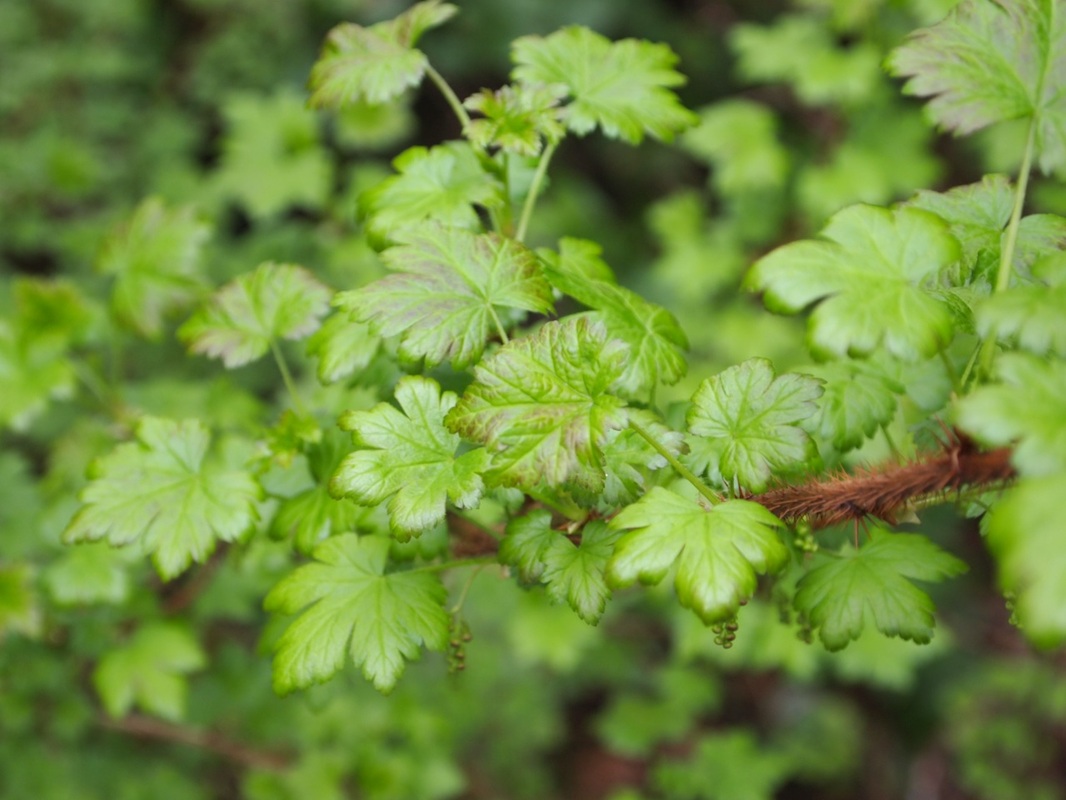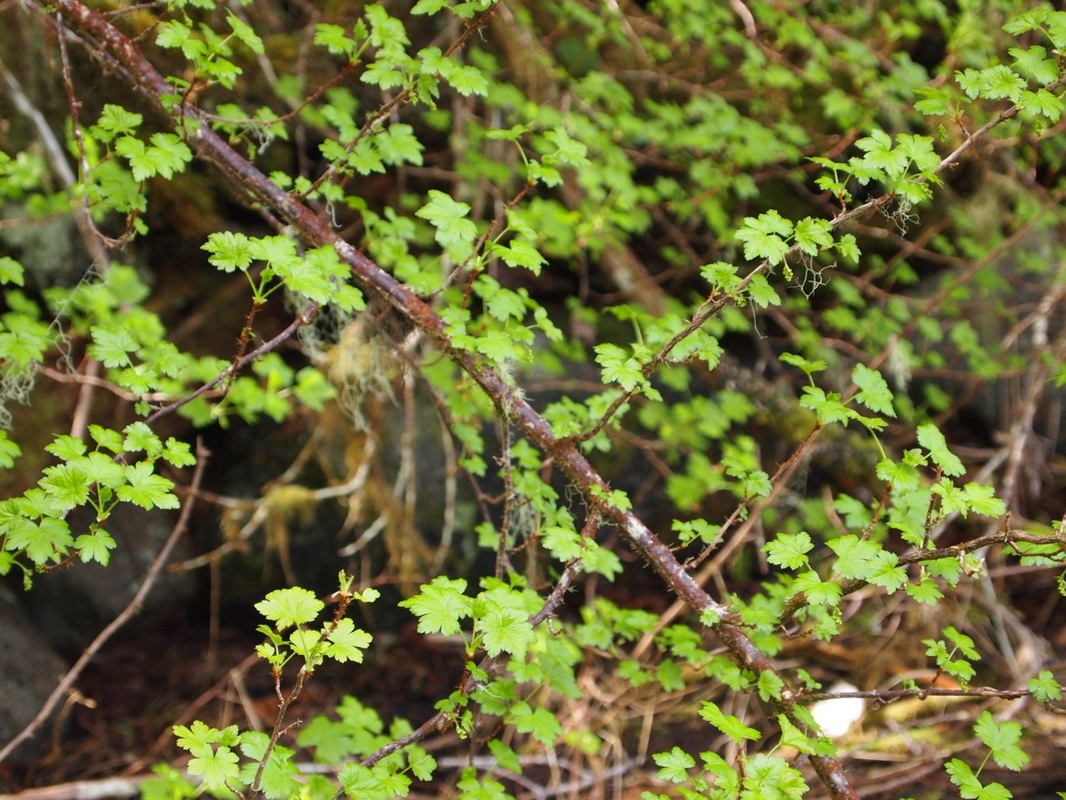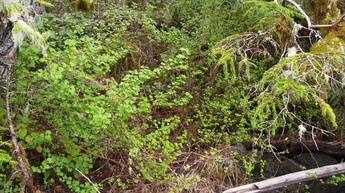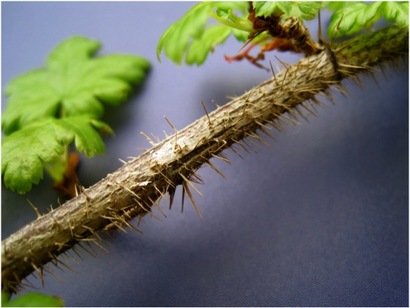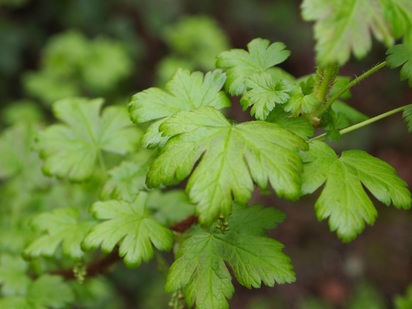Black gooseberry • Ribes lacustre
Identification
Black gooseberry is a upright to spreading, 0.5-2 m tall shrub. Its reddish-brown bark bears many small golden prickles as well as larger spines at leaf nodes. Its 2-7 cm long leaves alternate along leaf stems. They are coarsely toothed, deeply divided into five lobes, and roughly heart-shaped. The leaves are deciduous. Black gooseberry has small reddish saucer-shaped flowers; 7-15 flowers form hanging clusters. This species bears dark purplish-black, bristly berries.
Habitat & Range
Black gooseberry grows in a variety of semi-forested habitats such as moist forests and streambanks, and often grows on rotting wood. It is common in moist locations, and less common in drier water-shedding locations. Its range extends all across northern North America, and along the west coast from Alaska south to California.
Similar Species
Wild gooseberry (Ribes divaricatum) is the most similar gooseberry species found on the Central Coast. Its branches aren't covered in prickles; instead it has 1-3 large spikes at leaf nodes. Its flowers are elongated and its berries are smooth (not bristly). Other similar BC Ribes species are gummy gooseberry (R. lobbii), red-flowering currant (R. sanguineum), sticky currant (R. viscossimum), and northern blackcurrant (R. inerme). These species differ in flower and berry structure as well as presence or absence of spines and prickles; they are also not commonly found north of southern BC.
Black gooseberry is a upright to spreading, 0.5-2 m tall shrub. Its reddish-brown bark bears many small golden prickles as well as larger spines at leaf nodes. Its 2-7 cm long leaves alternate along leaf stems. They are coarsely toothed, deeply divided into five lobes, and roughly heart-shaped. The leaves are deciduous. Black gooseberry has small reddish saucer-shaped flowers; 7-15 flowers form hanging clusters. This species bears dark purplish-black, bristly berries.
Habitat & Range
Black gooseberry grows in a variety of semi-forested habitats such as moist forests and streambanks, and often grows on rotting wood. It is common in moist locations, and less common in drier water-shedding locations. Its range extends all across northern North America, and along the west coast from Alaska south to California.
Similar Species
Wild gooseberry (Ribes divaricatum) is the most similar gooseberry species found on the Central Coast. Its branches aren't covered in prickles; instead it has 1-3 large spikes at leaf nodes. Its flowers are elongated and its berries are smooth (not bristly). Other similar BC Ribes species are gummy gooseberry (R. lobbii), red-flowering currant (R. sanguineum), sticky currant (R. viscossimum), and northern blackcurrant (R. inerme). These species differ in flower and berry structure as well as presence or absence of spines and prickles; they are also not commonly found north of southern BC.
References
Giblin, D. Ribes lacustre. Burke Museum of Natural History and Culture. University of Washington. University of Washington, Seattle, Washington. Accessed 27/08/2014.
Pojar, J. and MacKinnon, A. (1994). Plants of Coastal British Columbia. Vancouver, BC: Lone Pine Publishing. P. 85.
Ribes lacustre (Pers.) Poir. In Klinkenberg, Brian. (Ed.). E-Flora BC: Electronic Atlas of the Plants of British Columbia. Lab for Advanced Spatial Analysis, Department of Geography, University of British Columbia, Vancouver. Accessed 27/08/2014.
Authors and editors of page
Kelly Fretwell and Brian Starzomski (2014).
Giblin, D. Ribes lacustre. Burke Museum of Natural History and Culture. University of Washington. University of Washington, Seattle, Washington. Accessed 27/08/2014.
Pojar, J. and MacKinnon, A. (1994). Plants of Coastal British Columbia. Vancouver, BC: Lone Pine Publishing. P. 85.
Ribes lacustre (Pers.) Poir. In Klinkenberg, Brian. (Ed.). E-Flora BC: Electronic Atlas of the Plants of British Columbia. Lab for Advanced Spatial Analysis, Department of Geography, University of British Columbia, Vancouver. Accessed 27/08/2014.
Authors and editors of page
Kelly Fretwell and Brian Starzomski (2014).
